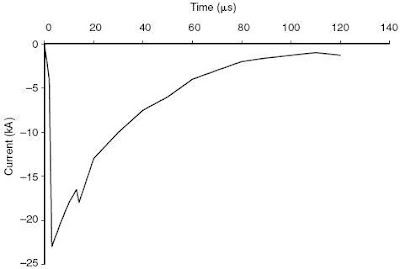Impulsive Transient is one of the two types of transient disturbance that may enter the power system. It is defined by IEEE 1159 as a sudden, non–power frequency change in the steady-state condition of voltage, current, or both that is unidirectional in polarity – either primarily positive or negative. It is normally a single, very high impulse like lightning.
Impulsive transients are generally described by their rise and decay times. They can also be characterized by their spectral content. To explain, a 1.2 X 50-μs 2000-V impulsive transient nominally increases from zero to its peak value of 2000 V in 1.2 μs. Subsequently, it decays to half its maximum value in 50 μs.
 |
| Typical current impulsive transient caused by lightning |
Impulsive transients are not usually transmitted far from the source of where they enter the power system. However, in some cases, they may propagate for some distance along distribution utility lines. Also, it may considerably have different characteristics when viewed from different parts of the electrical system (i.e. from one building to another). In addition, the high frequencies involved allow damping of the impulsive transients through the resistive component of the system.
Impulsive transients are further subdivided into three categories:
 |
| Impulsive Transients Categories |
Nanosecond transients generally exist near the source of the disturbance. It rises in 5 ns with a duration of less than 50 ns.
Microsecond impulsive transients are relatively unusual, but they have much higher amplitudes. They do not conduct as easily as the millisecond types but may cause arcing faults on the electrical system. It rises in 1μs and has a duration of 50 ns to 1 ms.
Millisecond impulsive transient is the most common to occur in a power system. It rises in 0.1 ms and lasts more than 1 ms.
Causes
Electrostatic Discharge is another form of an impulsive transient. Most of us are familiar with this, since we may have already experienced such when touching an object (door knob) or another person, after walking across a carpeted floor. The sudden release of charge can damage sensitive electronics. This is the main reason why technicians use wrist straps when servicing electronic equipment.
Effects
The effects of transients on a power system depend on the amplitude of the transient and its frequency. In the case of impulsive transients, its amplitude is the main cause of problems. The damage caused by a transient can be immediate (i.e. lightning strike). It can also be gradual as in the case of low-amplitude transients, which slowly degrade equipment insulation making it prone to short circuit. This gradual destruction is sometimes referred to as a “slow death by a thousand cuts”.
Furthermore, impulsive transients can excite power system resonance circuits and produce the other type of transient disturbance - Oscillatory Transients.
References:
IEEE 1159-1995. Recommended Practice For Monitoring Electric Power Quality.
Giordano, J. (2005). Sidebar: The Basics of Voltage Transients


1 comment:
You can test impulsive transients economically using an SCR ELEKTRONIKS Impulse Voltage Tester
Post a Comment